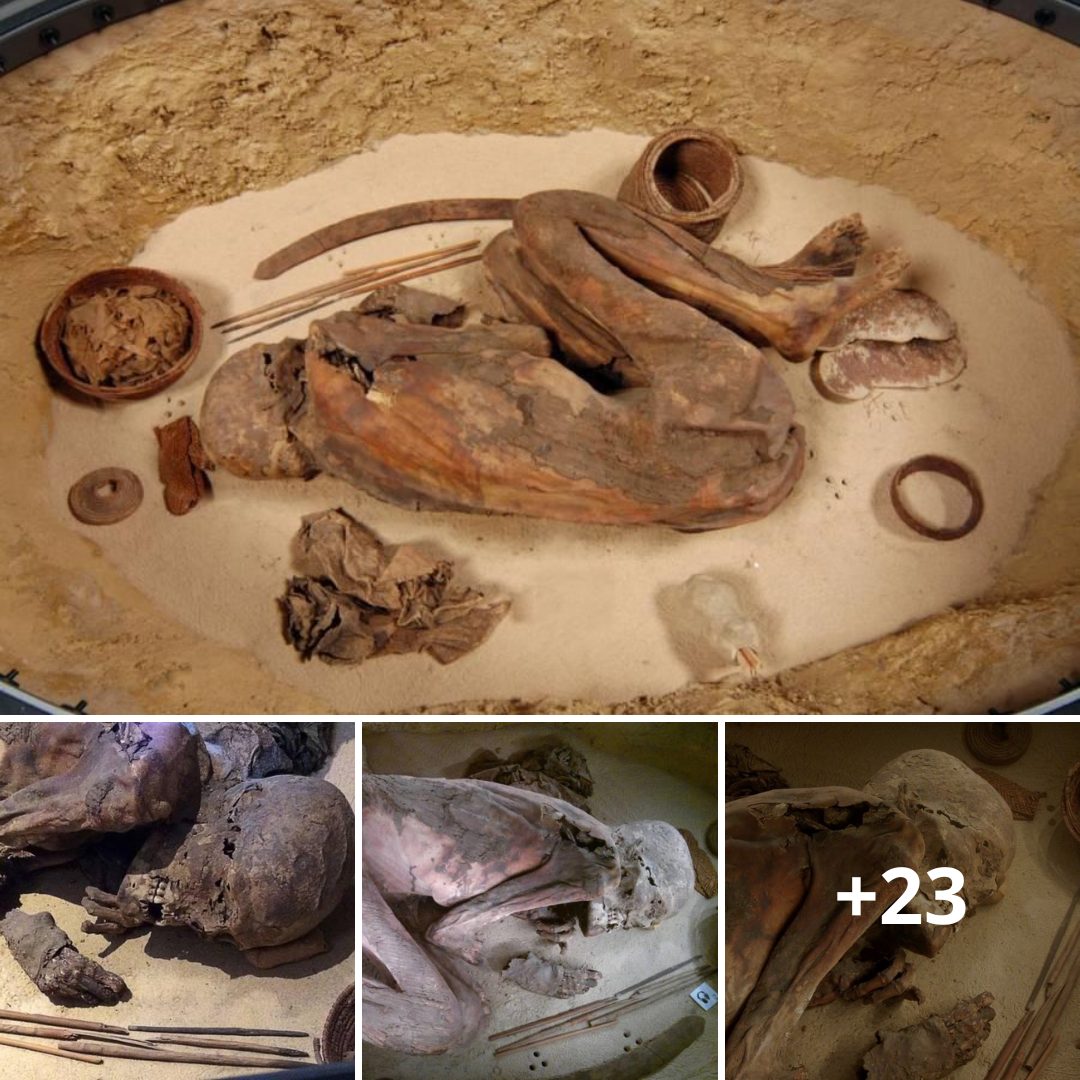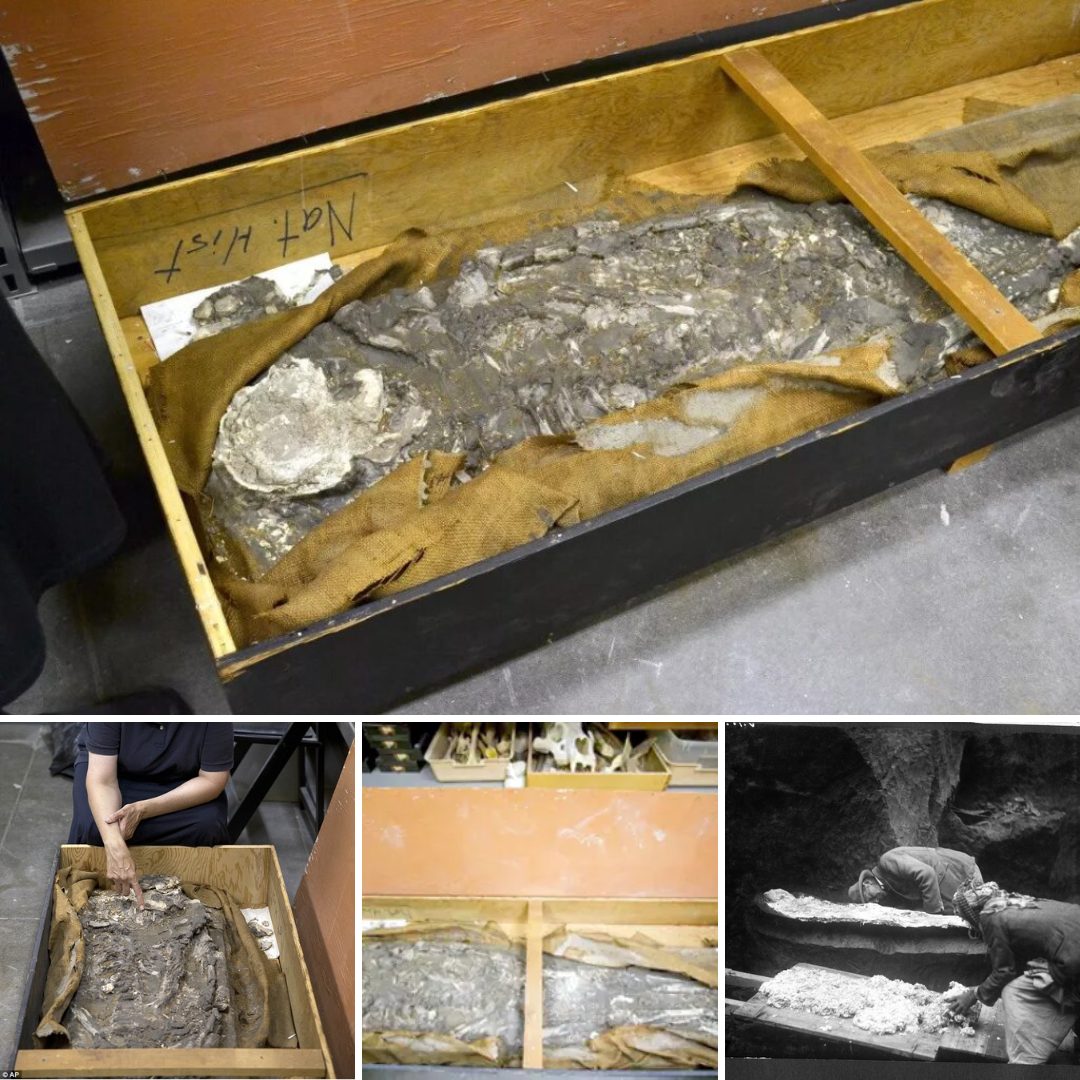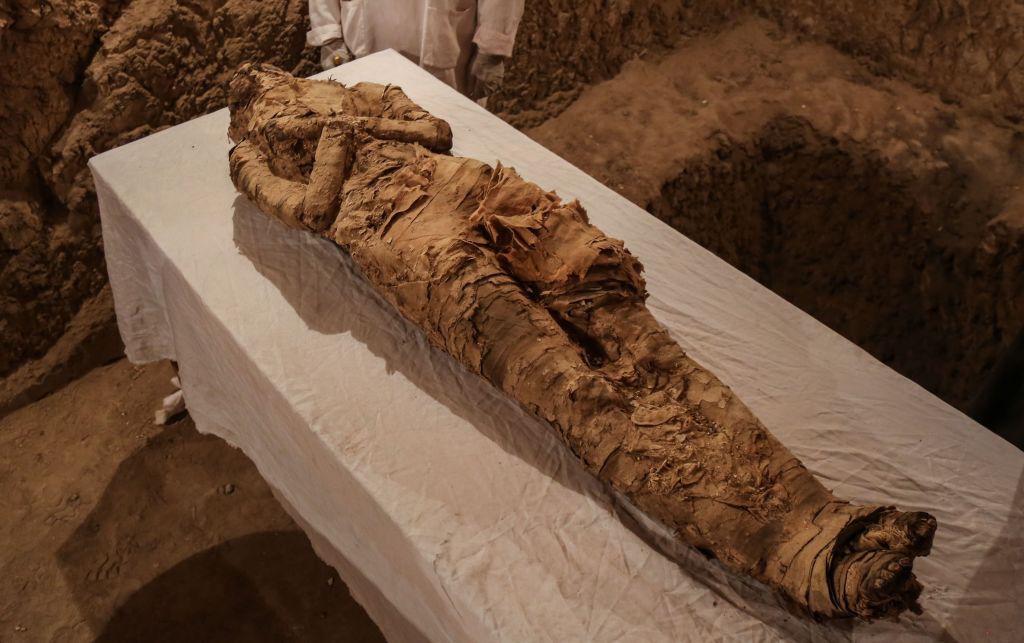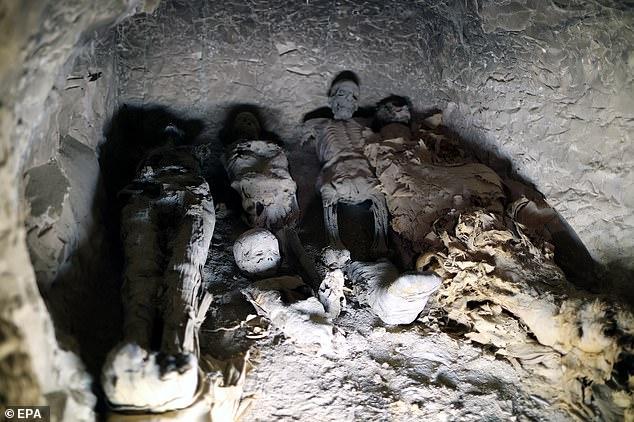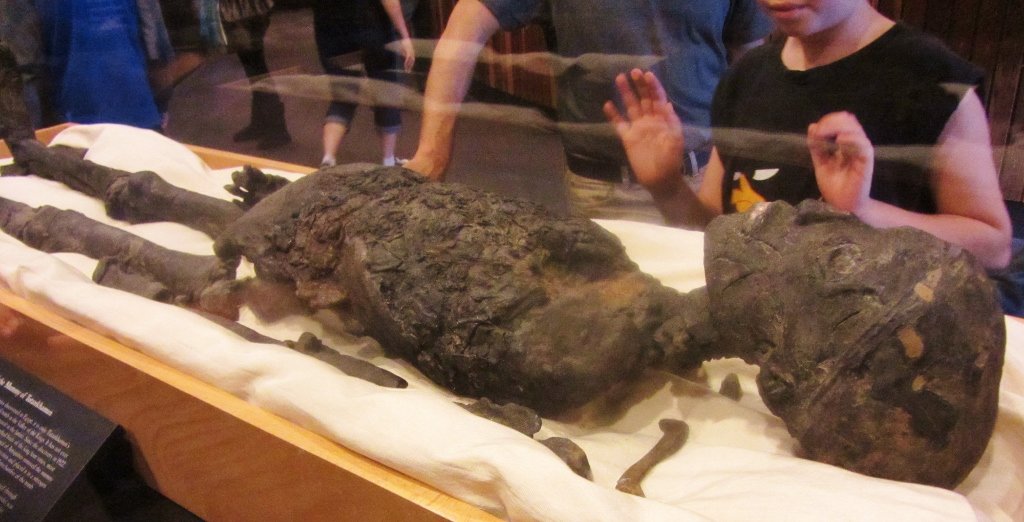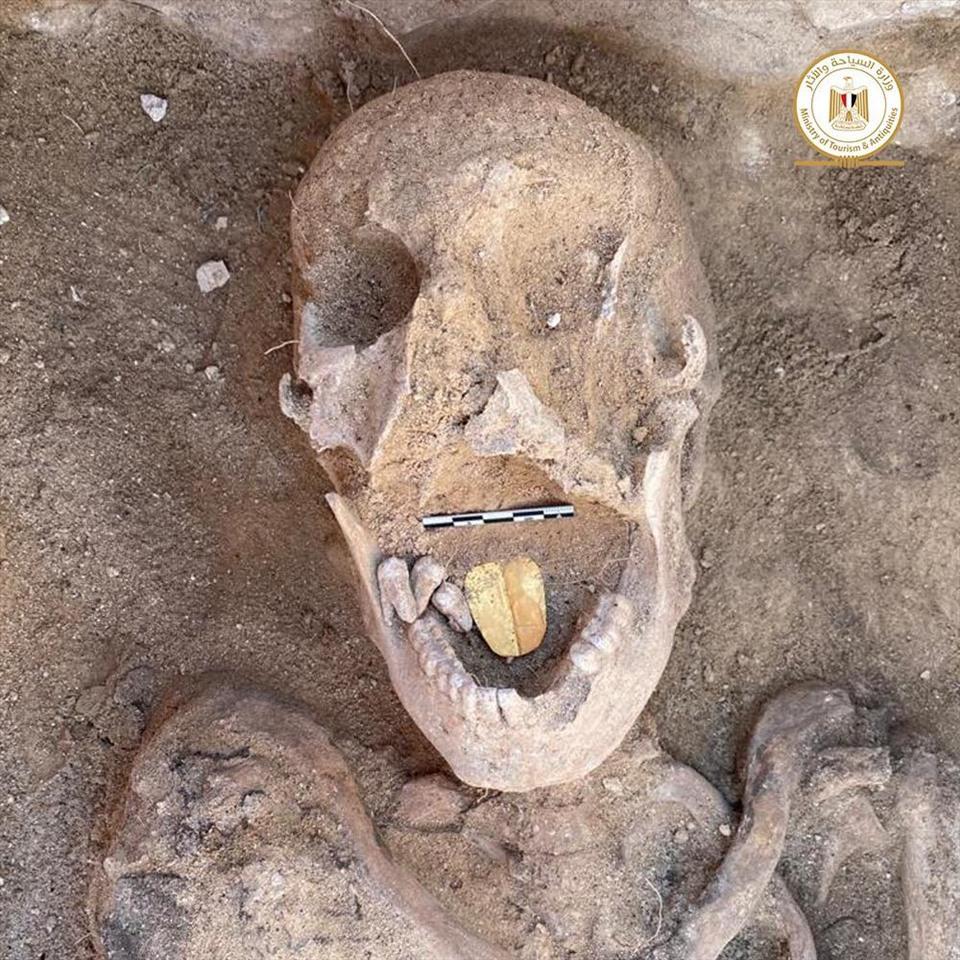Revealing Pompeii’s Lost Souls: Unprecedented CT Scans Illuminate Ancient Tragedy
After being entombed in ash for more than 1,900 years, the victims of the devastating eruption in Pompeii are being brought to life using modern-day imaging technology.
Archaeologists have spent the past year carefully restoring and scanning the preserved bodies of 86 Romans who died when Mount Vesuvius erupted in 79AD.
Now, the restorers have released the first results of these scans to show what lies under the plaster and casings of these people frozen in time.
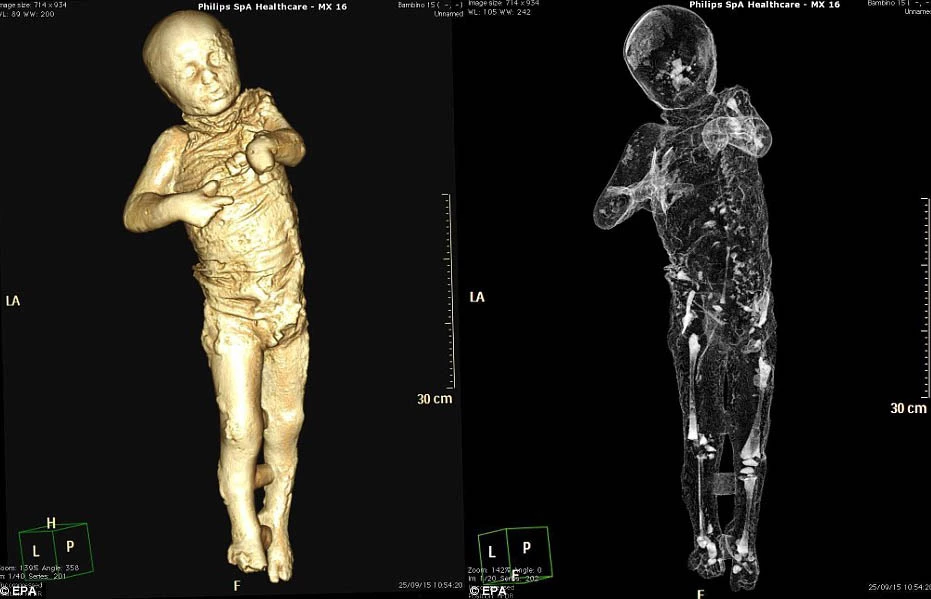
Archaeologists have spent the past year carefully restoring and scanning the preserved bodies of 86 Romans who died when Mount Vesuvius erupted near Pompeii in 79AD. They have now released the first results of these scans to show what lies beneath the plaster and casings of the people frozen in time (scans of a victim believed to have been four years old when he died is shown)
Perhaps the most surprising discovery was the excellent conditions of the Roman’s teeth. Researchers say it suggests they must have had a low sugar, high fibre diet and may even had eaten better than we did.
Among the victims to be scanned was a boy, believed to be around four years old, found frozen in terror.
He was discovered alongside an adult male and female, presumed to be his parents, as well as a younger child who appeared to be asleep on his mother’s lap.
The little boy’s clothing is visible in the plaster cast but now scans have revealed his tiny skeleton beneath these clothes.
One scan in particular resembles the 3D scans taken by doctors during pregnancy and show the young boy’s lips pursed, as if in shock.
The spine, ribs and pelvis of another victim, believed to be an adult male, have also been revealed by the project.
Other scans attempt to bring the skull of another victim to life using a specific contrast dye that mimics the appearance of muscles and skin.
These more gruesome scans help accentuate the victim’s teeth, but their empty eye sockets and collapsed nose give them a macabre feel.
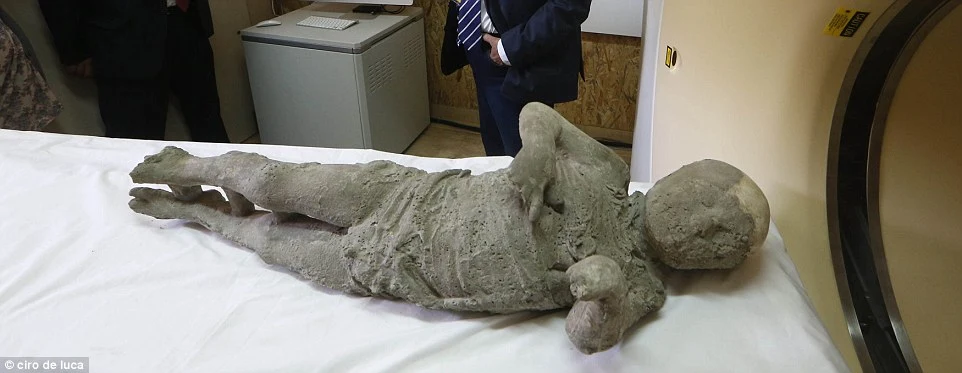
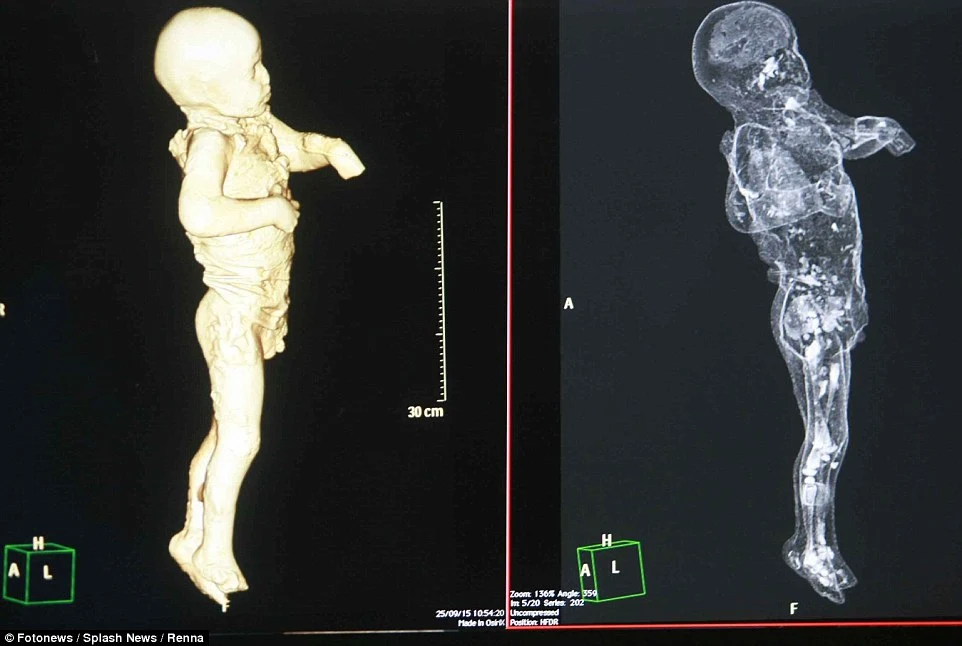
The little boy’s clothing is visible in the plaster cast but now scans have revealed his tiny skeleton beneath these clothes. One scan (left) resembles the 3D-scans taken during pregnancy and shows the young boy’s lips pursed, as if in shock
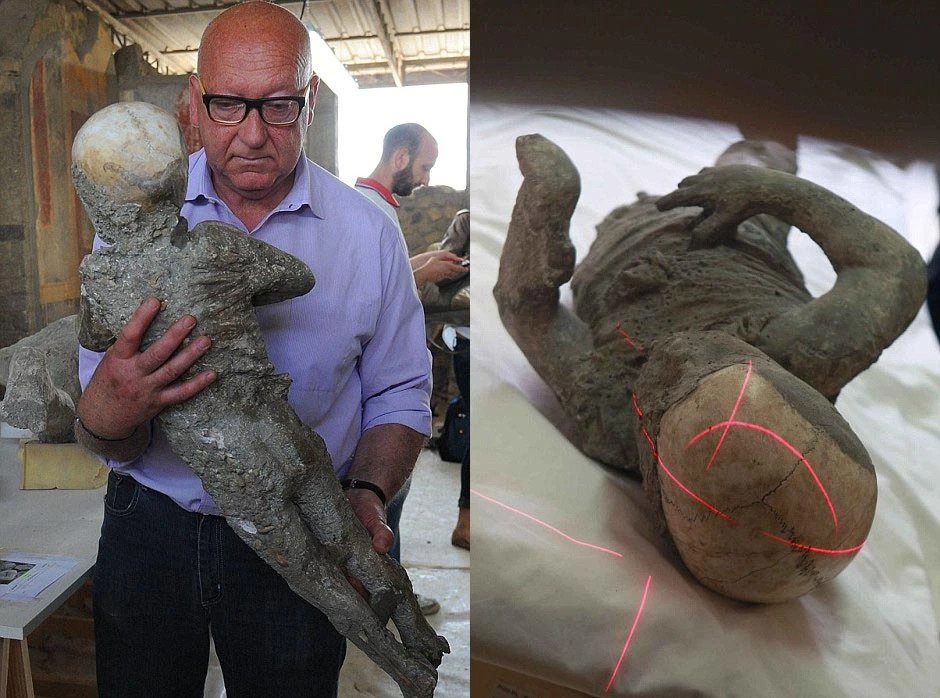
Experts at the Pompeii Archaeological Site have been readying the poignant remains for the exhibition called Pompeii and Europe. Stefano Vanacore, director of the laboratory at Pompeii Archaeological Site can be seen carrying the remains of the petrified child in his arms (left). Lasers used as part of the scanning process are shown on top of the boy’s head in the right-hand picture
The scans have also revealed that many of the victims at Pompeii suffered severe head injuries perhaps caused by falling rubble as their homes collapsed in the earthquakes that accompanied the eruption.
Experts at the Pompeii Archaeological Site have been readying the poignant remains for the exhibition called Pompeii and Europe.
Over the years, many of the victims have been encased in plaster casts to help preserve them and their positions.
The restoration involves carefully breaking into these casts to reveal the bodies entombed in ash. The scans are used on bodies that are too delicate to break open, or to capture the details within the ash.
Computerised axial tomography (CAT) machines, also known as CT scanners, are used because they produce detailed 3D models of the remains.
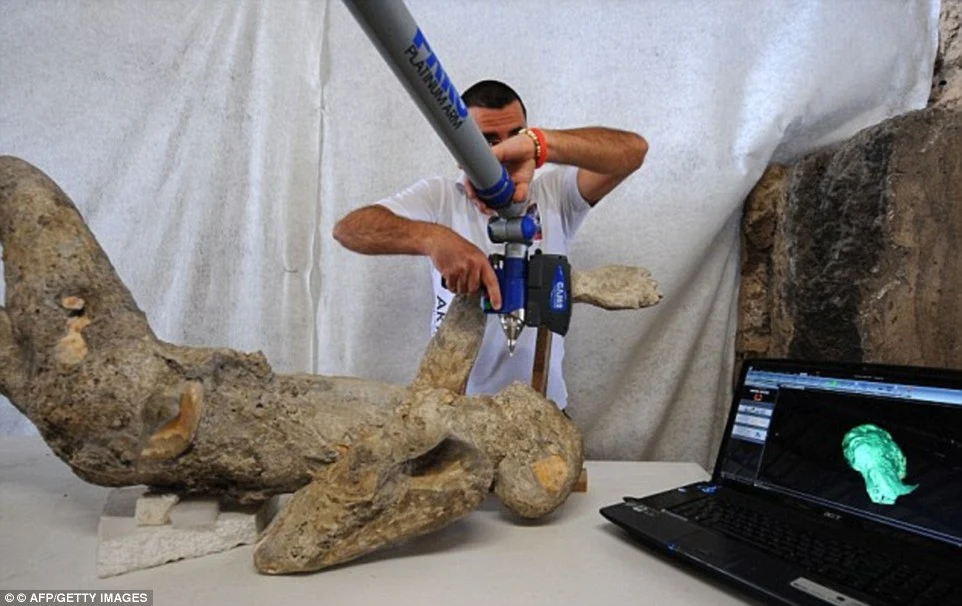
Handheld scanners are also used to determine the features and positions of the bodies beneath the casts (pictured), especially those that are too fragile to fit inside the scanners. The scans are taken to prevent the restorers from accidentally damaging the remains
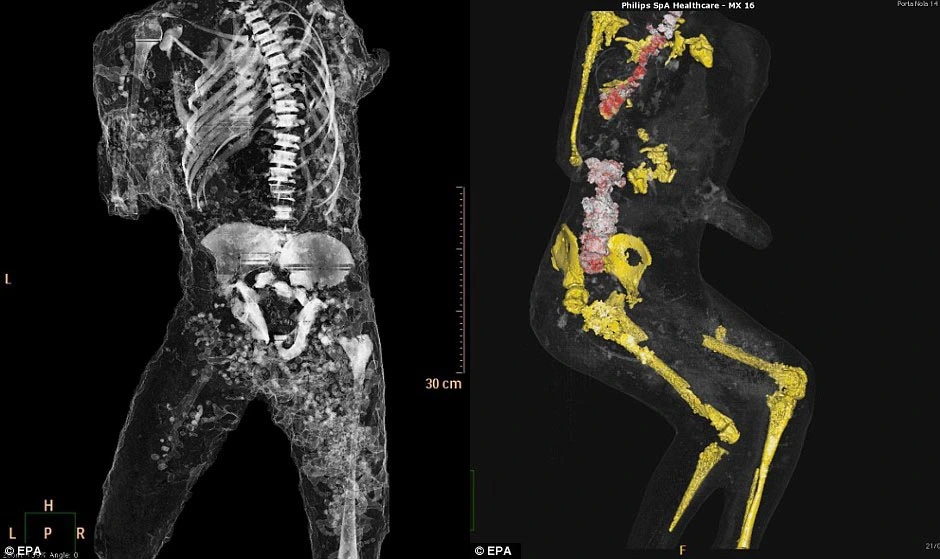
The spine, ribs and pelvis of another victim (left) have also been revealed by the project. The right-hand image has marked out the pelvis, femurs and knee bones of a further victim. The bones are shown in various colours to make them easier to distinguish from one another
In particular, tomography is the process of creating a 2D image or ‘slice’ of a 3D object.
They are used by doctors to examine the body one slice at a time to pinpoint specific areas, and the same method is used when studying the remains.
It is becoming a common method for examining archaeological remains and has previously been used to study Egyptian mummies, for example.
Stefania Giudice, a conservator from Naples national archaeological Museum who is working on the Pompeii victims: ‘It can be very moving handling these remains.’
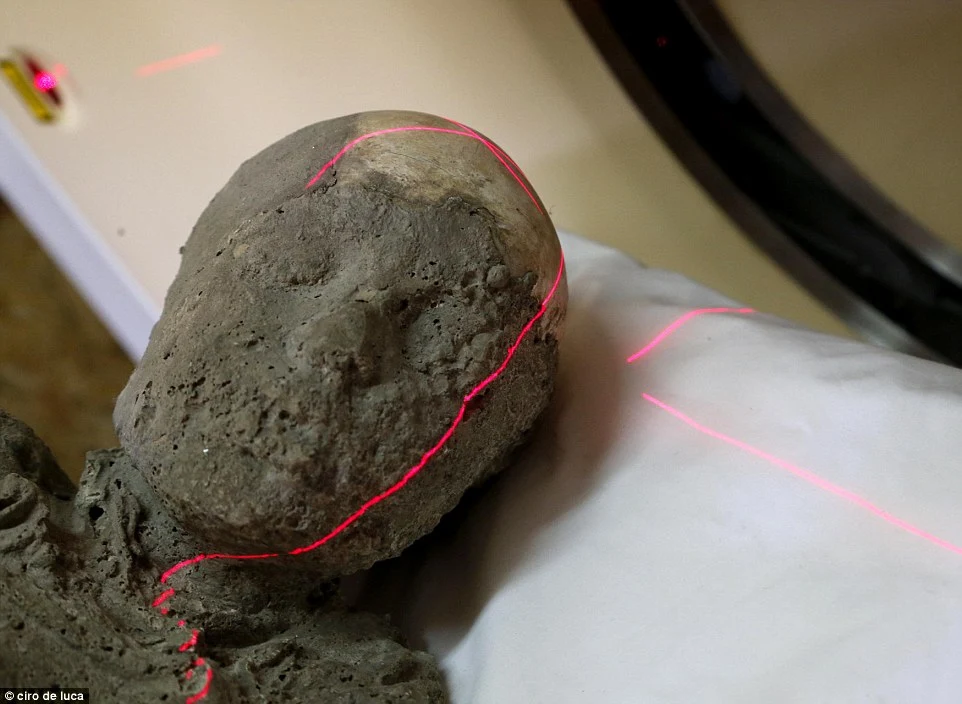
Computerised axial tomography (CAT) machines (pictured scanning a victim), also known as CT scanners, are used because they produce detailed 3D models of the remains. In particular, tomography is the process of creating a 2D image or ‘slice’ of a 3D object. They are used by doctors to examine the body one slice at a time to pinpoint specific areas, and the same method is used when studying the remains
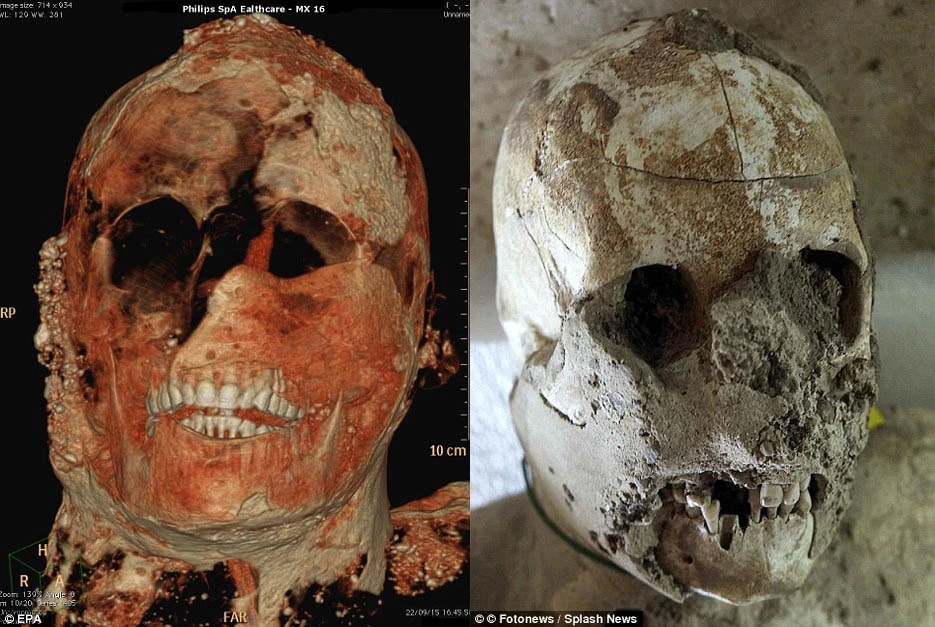
Other scans attempt to bring the skull of another victim to life using a specific contrast dye that mimics the appearance of muscles and skin. These scans help accentuate the victim’s teeth, but their empty eye sockets and collapsed nose give them a macabre feel
‘Even though it happened 2,000 years ago, it could be a boy, a mother or a family. It’s human archaeology, not just archaeology.’
The people’s poses reveal how they died, some trapped in buildings and others sheltering with family members.
In one haunting image, Stefano Vanacore, director of the laboratory can be seen carrying the remains of the tiny child in his arms who was imprisoned in ash when the volcano erupted on 24 August.
Another plaster cast of an adult reveals he raised his hands above his head in a protective gesture, seemingly in a bid to stave off death.
Pompeii was a large Roman town in the Italian region of Campania.
Mount Vesuvius unleashed its power by spewing ash hundreds of feet into the air for 18 hours, which fell onto the doomed town, choking residents and covering buildings.
But the deadly disaster occurred the next morning, when the volcano’s cone collapsed, causing an avalanche of mud travelling at 100mph (160km/h) to flood Pompeii, destroying everything in its path and covering the town so that all but the tallest buildings were buried.
People were buried too in the ash, which hardened to form a porous shell, meaning that the soft tissues of the bodies decayed, leaving the skeleton in a void.
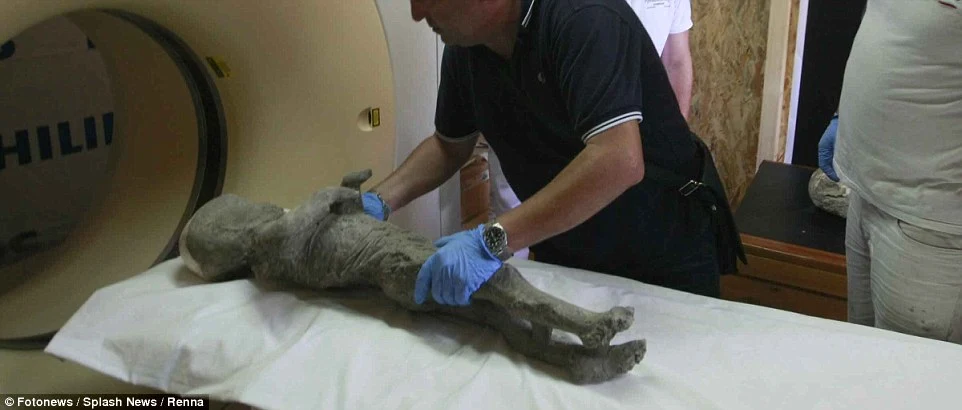
Reports claim two thousand people died in Pompeii and the location was abandoned until it was rediscovered in 1748. Stefania Giudice, a conservator from Naples national archaeological Museum said: ‘It can be very moving handling these remains’ (the child victim is shown)
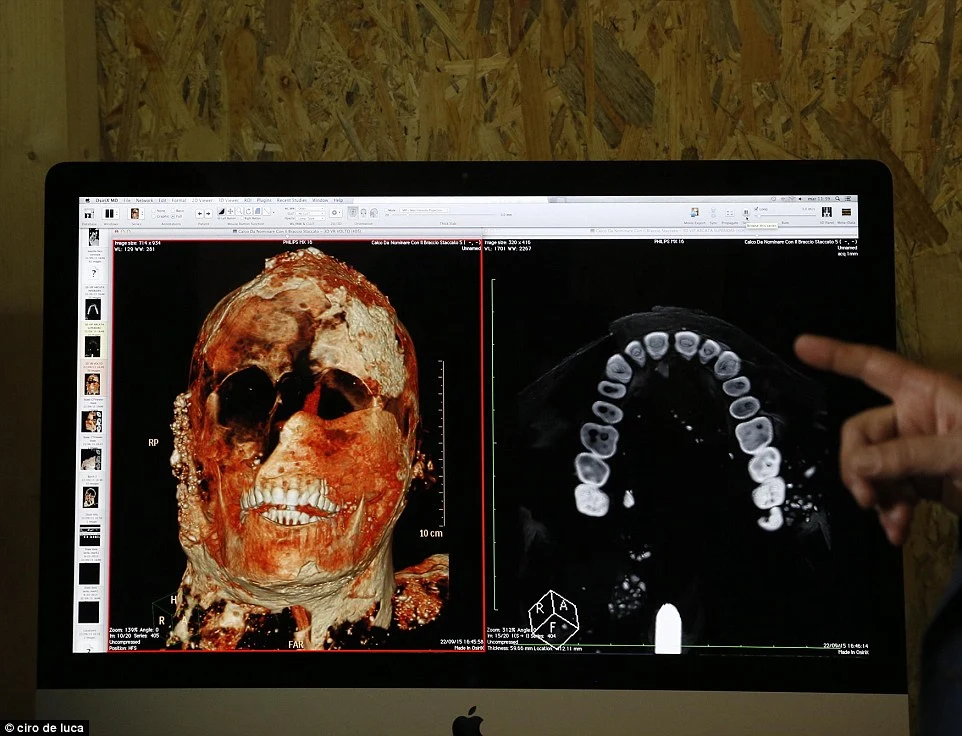
Once the scans are taken, experts can rotate and study the images in greater detail than is possible when studying the physical remains. The inside of this victim’s mouth including teeth and even cavities are pictured
Reports claim two thousand people died, and the location was abandoned until it was rediscovered in 1748. Many of the buildings, artefacts and skeletons were found intact under a layer of debris.
It is now classified as a Unesco World Heritage Site and more than 2.5 million tourists visit each year.
In November, French and Italian archaeologists excavating areas of the ancient town found raw clay vases that appear to have been dropped by Roman potters fleeing the disaster.
The perfectly-preserved settlement was discovered by accident in the 18th century, buried under 30ft of ash.
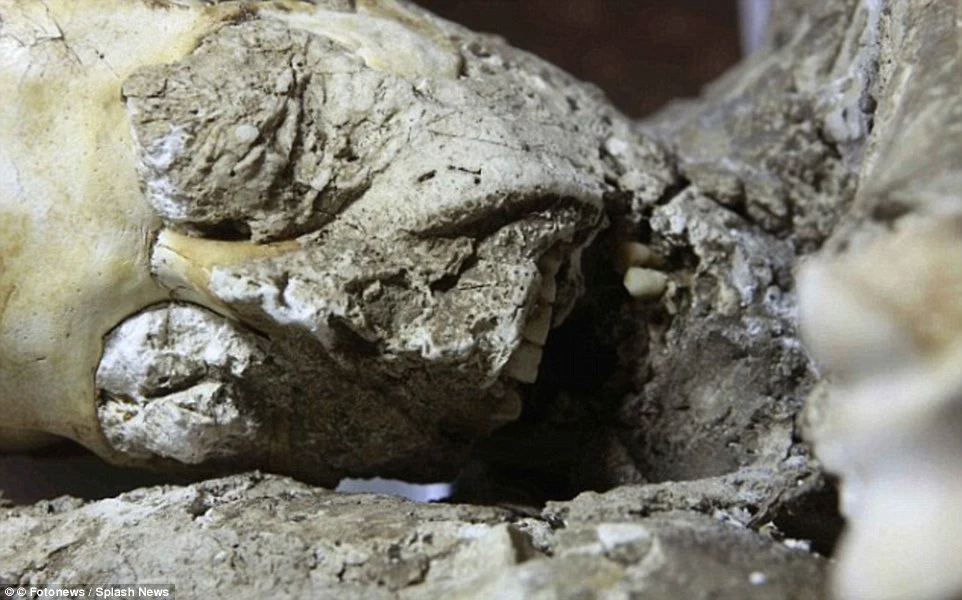
The majority of plaster casts were made in the mid 19th century, meaning that some have degenerated and need repairing, offering experts a glimpse inside them. When the human remains were first found archaeologists poured plaster inside to capture the positions the people were in when they died (pictured)
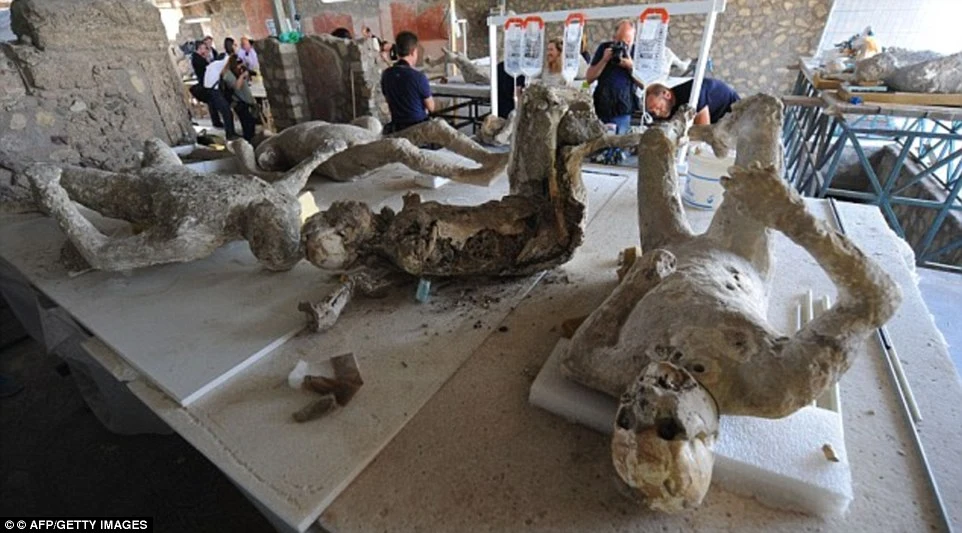
Many of the buildings, artefacts and skeletons (selection pictured) were found intact under a layer of debris. The site is now classified as a Unesco World Heritage Site and more than 2.5 million tourists visit each year
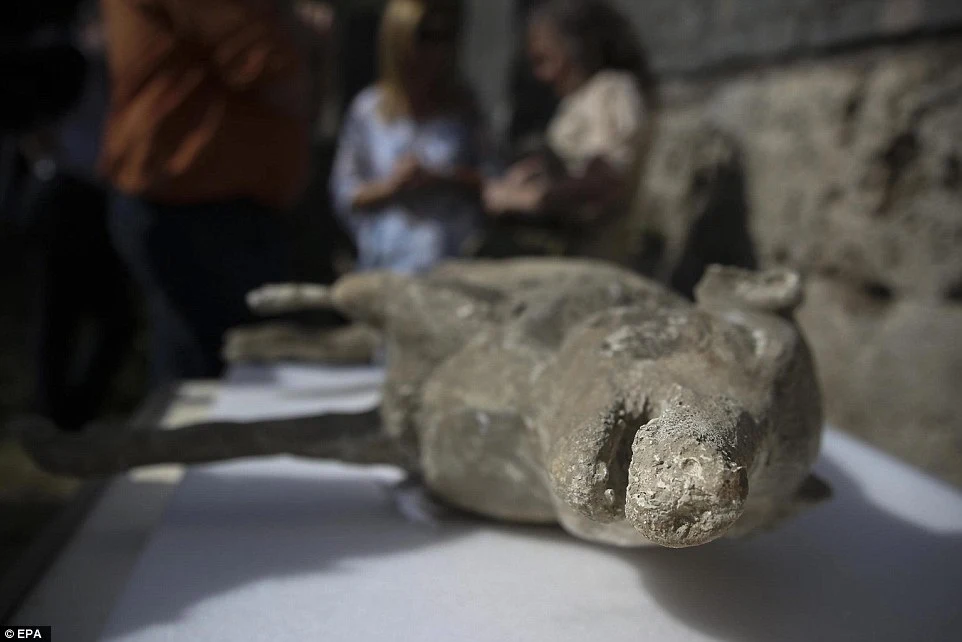
In all, only around 100 of the victims have been captured in plaster, to reveal people’s poses as well as pet dogs (pictured), for example. It is estimated that anywhere between 10,000 and 25,000 residents of Pompeii and nearby Herculaneum were killed on the spot
Excavators were amazed to find human remains inside voids of the ash and soon worked out how to create casts of the people to capture a moment frozen in time.
Archaeologists poured plaster inside to capture the positions the people were in when they died, trapping their skeletons inside the plaster before removing the cast from the hole a couple of days later.
The technique means it’s possible to see the anguished and pained expressions of men, women and children who all perished as well as details such as hairstyles and clothes.
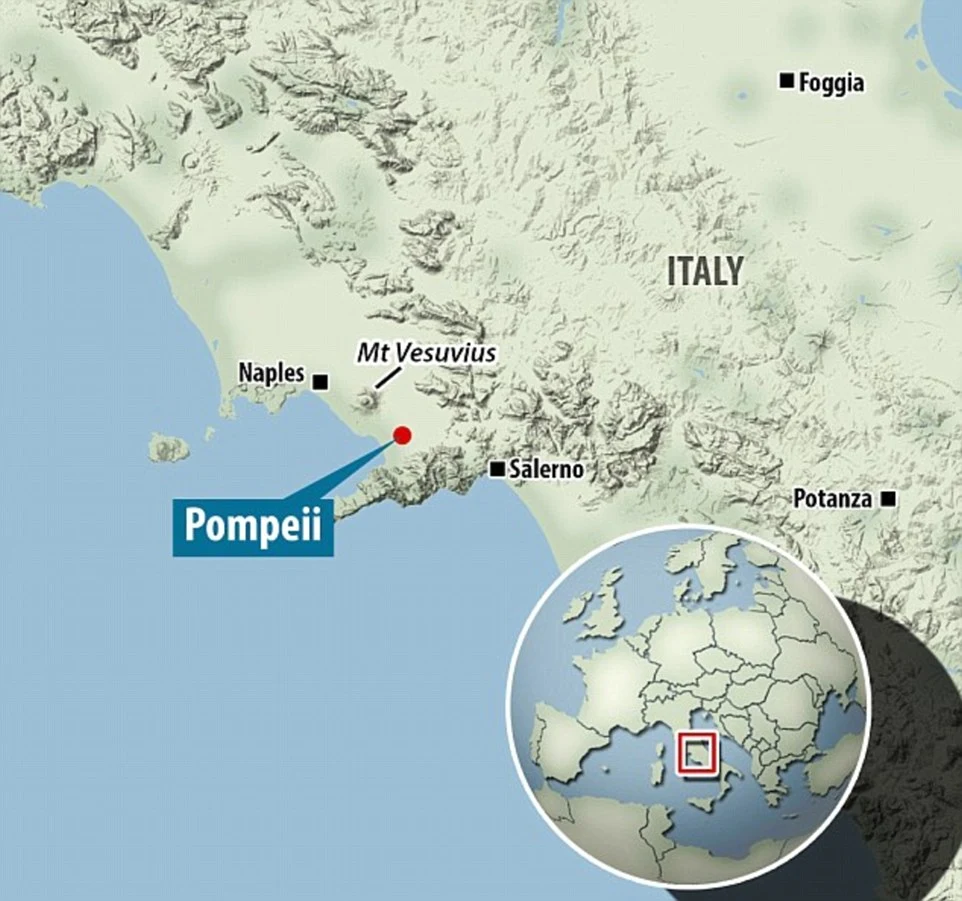
Pompeii was a large Roman town in the Italian region of Campania (marked). Mount Vesuvius unleashed its power by spewing ash hundreds of feet into the air for 18 hours, which fell onto the doomed town, choking residents and covering buildings. The deadly disaster occurred the next morning, when the volcano’s cone collapsed, causing an avalanche of mud travelling to flood Pompeii
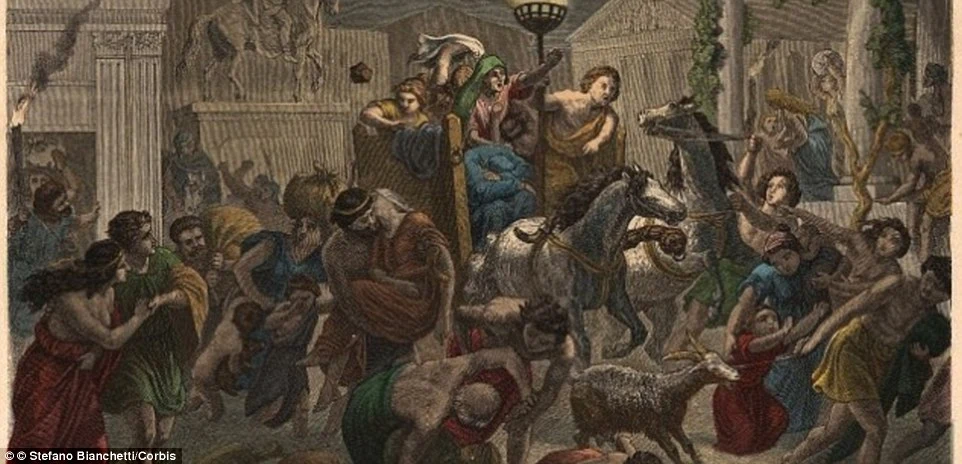
Roman writer, Pliny the younger, described the panic during the eruption of Mount Vesuvius. Terrified Romans (illustrated) living in the towns of Pompeii and Herculaneum saw ‘sheets of fire and leaping flames’ as they ran through dark streets carrying torches with pumice stone raining down upon them, he said
Creating casts is an exact science, because the plaster must be thin enough to show details of the person but thick enough to support the remains.
Approximately 1,150 bodies have been discovered so far, although a third of the city has yet to be excavated.
The majority of plaster casts were made in mid 19th century, meaning that some have degenerated and need repairing, offering experts a glimpse inside them.
In all, only around 100 of the voids have been captured in plaster, to reveal people’s poses as well as writhing pet dogs, for example. It is estimated that anywhere between 10,000 and 25,000 residents of Pompeii and nearby Herculaneum were killed on the spot.
Science of Preserving Victims Entombed in Ash by Mount Vesuvius
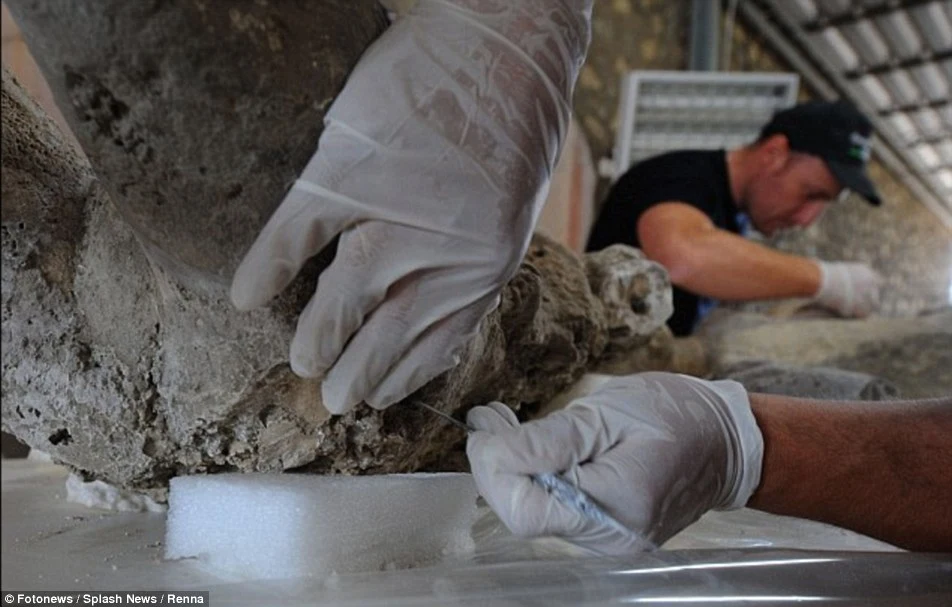
Archaeologists have been looking at new ways to preserve Pompeii’s victims without plaster. In 1984, one skeleton was cast using resin, to create a durable cast allowing the victim’s hair and hairpin to be captured perfectly. But resin casting is difficult and expensive so it has only been used once. Plaster remains a good option for making casts. An archaeologist is shown breaking into the plaster of a victim
Archaeologists have looked at new ways to preserve Pompeii’s victims without plaster.
In 1984, one skeleton was cast using resin, to create a durable cast allowing the victim’s hair and hairpin to be captured perfectly.
But resin casting is difficult and expensive so it has only been used once.
Plaster remains a good option for making casts, despite the technique being pioneered more than a century ago.
It has to be mixed to a precise consistency – thick enough to support the skeleton, but thin enough to capture as many details possible.
The mixture has to be carefully poured into the void in the ash through a narrow entrance to capture a person’s pose.
Dr Giudice said: ‘The bones are very brittle so when we pour in the plaster we have to be very careful, otherwise we might damage the remains and they would be lost to us forever.’
